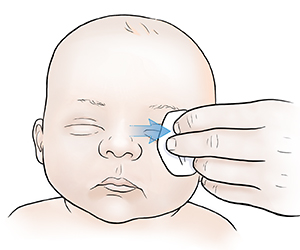Chlamydia is a sexually transmitted infection (STI). Some birth parents may not know that they have this infection. If you have chlamydia while you are pregnant, you can pass it to your child during birth. This is called chlamydia infection acquired at birth. Symptoms can appear in a newborn in the first few weeks after birth.
Chlamydia often causes an eye infection called conjunctivitis. The clear covering of the eye and the inner lining of the eyelids become red and irritated. The eyelids are swollen. The eyes have a watery discharge. This discharge may be white, yellow, or green. Most newborns are given an antibiotic ointment in their eyes after birth. But this doesn't prevent chlamydial conjunctivitis.
Chlamydial conjunctivitis is treated with antibiotics taken by mouth (oral). In most cases, symptoms go away a few days after the medicine is started.
Home care
Medicines
Your baby will likely be prescribed an antibiotic to treat the infection. Follow all instructions for giving the medicine to your baby. Be sure to give all of the medicine, even if your baby's symptoms have stopped. Artificial tears may also be prescribed to ease eye discomfort.
General care
-
Wash your hands well with soap and warm water before and after caring for your baby.
-
Use warm water or artificial tears to rinse the eye every few hours while your baby is awake. Gently wipe crusts or fluids away from the eyes. Use a wet swab or a warm, damp washcloth. When cleaning the eye, wipe from the nose to the outer eye. Use a different cloth for each eye.
-
Try to prevent your baby from rubbing their eyes.
-
To help soothe pain and swelling, you may apply a cool washcloth on the eye. Use a different cloth for each eye.
-
Wash your baby’s sheets and clothes separately from the family’s laundry. This will help prevent the spread of the infection.
Follow-up care
Follow up with your child’s health care provider as advised.
Special note to parents
Talk to your health care provider about getting tested and treated for your chlamydia infection.
When to get medical advice
Contact your child's health care provider right away if:
-
Your baby has a fever. (See "Fever and children" below.)
-
Your baby's eyelid is red, swollen, and leaking fluid for more than 2 days after starting treatment.
-
Your baby has ongoing signs of infection, such as redness or swelling of the eyelid or more fluid leaking from the eyes.
-
Your baby is breathing very fast or having trouble breathing.
-
Your baby has a cough that won’t go away.
-
Your baby isn't feeding well or isn't gaining weight.
-
Your baby seems very ill.
Fever and children
Use a digital thermometer to check your child’s temperature. Don’t use a mercury thermometer. There are different kinds and uses of digital thermometers. They include:
-
Rectal. For children younger than 3 years, a rectal temperature is the most accurate.
-
Forehead (temporal). This works for children aged 3 months and older. If a child under 3 months old has signs of illness, this can be used for a first pass. The health care provider may want to confirm with a rectal temperature.
-
Ear (tympanic). Ear temperatures are accurate after 6 months of age, but not before.
-
Armpit (axillary). This is the least reliable but may be used for a first pass to check a child of any age with signs of illness. The provider may want to confirm with a rectal temperature.
-
Mouth (oral). Don’t use a thermometer in your child’s mouth until they are at least 4 years old.
Use the rectal thermometer with care. Follow the product maker’s directions for correct use. Insert it gently. Label it, and make sure it’s not used in the mouth. It may pass on germs from the stool. If you don’t feel okay using a rectal thermometer, ask the provider what type to use instead. When you talk with a provider about your child’s fever, tell them which type you used.
Below are guidelines to know if your young child has a fever. Your child’s provider may give you different numbers for your child. Follow your provider’s specific instructions.
Fever readings for a baby under 3 months old:
(First, ask your child’s provider how you should take the temperature.)
-
Rectal or forehead: 100.4°F (38°C) or higher
-
Armpit: 99°F (37.2°C) or higher
Featured in


